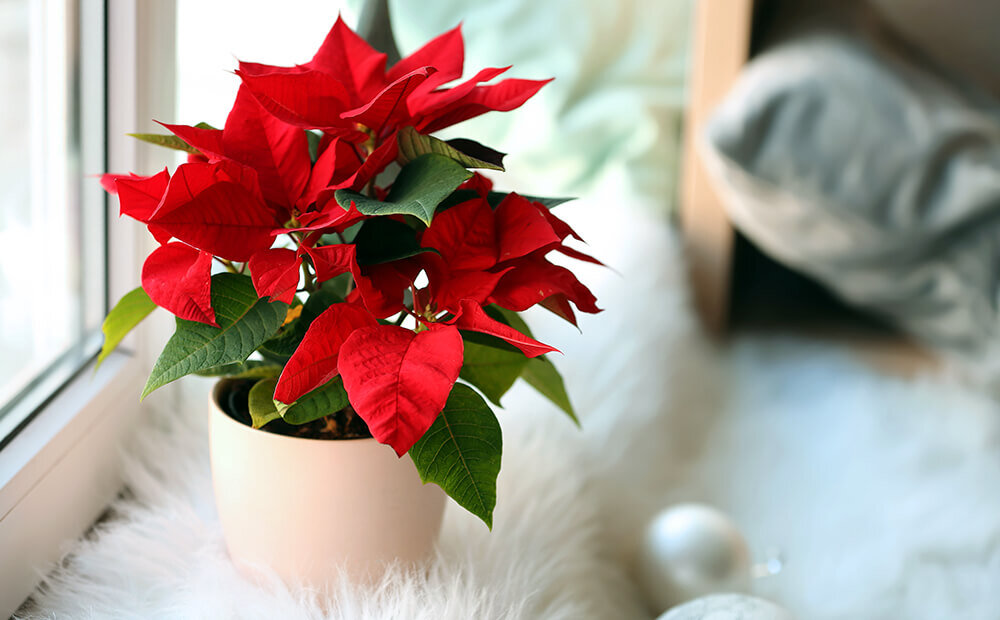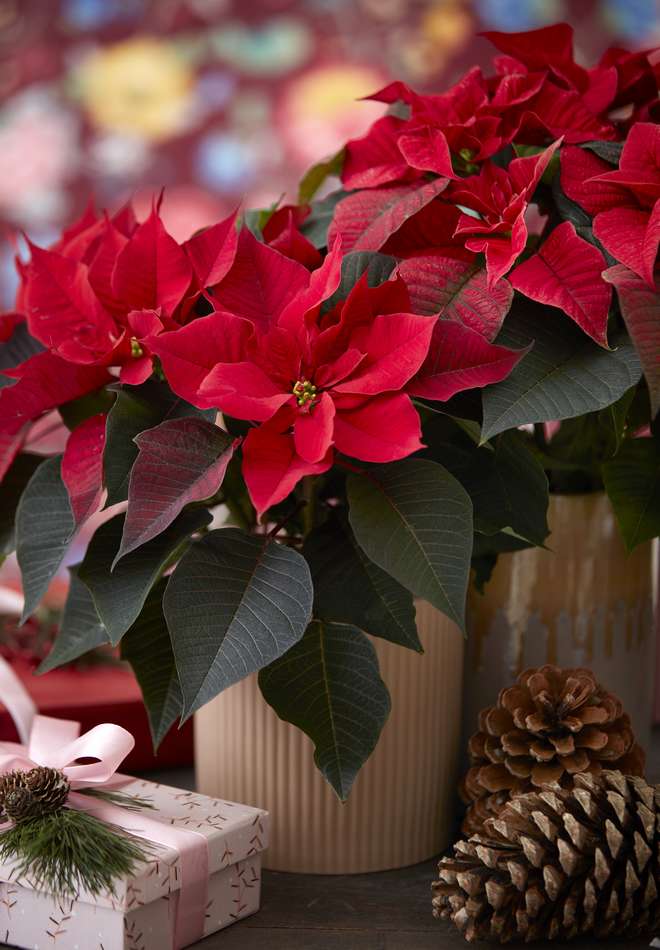
In Mexico, the Poinsettia forms a shrub several meters high. In USA, it is sold in pots, most often at Christmas time, as a houseplant 40 to 60 cm tall. Find out how to care for it and how to keep a poinsettia beyond the holiday season.
Colorful but fragile
The Poinsettia has long, green, stalked leaves. The bloom is not what you think it is. Botanically, the real flowers, tiny and yellow, go almost unnoticed.
The colored parts are large leaves called bracts. These bracts are colored white, cream, pink or red and are used as a Christmas decoration on the New Year’s table.
Some varieties even feature beautiful mixed colors or a marbled appearance for even more originality.
Flowers appear between October and December and persist until the end of winter. While the Poinsettia stands out for its beauty, it is still difficult to flower and keep healthy.

Caring for Poinsettia in pots
- Grow your Poinsettia in a bright area, but out of direct sunlight. This is because the sun, especially if your plant is right behind a window, suddenly dries up red leaves and new growth. A cool, lightly heated room (between 15 and 20 °) is ideal.
- Avoid the proximity of radiators and ensure that the temperature remains roughly constant. The Poinsettia hates sudden changes in growing conditions. It also cannot stand drafts. Be careful when you ventilate your room in the morning!
- Once the flowering period is over, move your Poinsettia to a cool, bright place where it will enjoy a temperature that does not drop below 14/15 ° C.
How to water a poinsettia?
- First of all, the bottom of the pot must always be pierced and there must not be a saucer underneath. he roots can’t stand bathing in water!
- Based on the temperature of the room, estimate the watering needs of your Poinsettia. There is no set rule because growing conditions vary from place to place. However, add water at least once a week during flowering. Use room temperature, non-hard water.
- The substrate should remain moist but not excessively.
- Leave it all the same to dry on 2 to 3 cm of depth between two waterings.
- Also be careful not to let water stagnate in the saucer, empty it quickly otherwise the roots and stems will rot.
- If the room temperature exceeds 18 ° C, place the plant on clay balls to keep humidity around.
- Also regularly mist the foliage, which will ward off whitefly (whitefly), the main disease in dry interiors.
Once flowering is complete, reduce watering to every 10 days
What fertilizer should you use for a potted poinsettia?
It is important to fertilize your plant regularly to keep it healthy and make it bloom again.
To do this, add fertilizer for flowering plants every 15 days during the flowering period.
From April to September, use a fertilizer for green plants, which is richer in nitrogen (N) instead.
When and how to repot poinsettia?
Repot your poinsettia at the end of flowering, in the spring.
Then replant your Christmas Star in a mixture of good horticultural soil mixed with sand or fine pozzolana.
How to cut the Christmas star?
Once flowering is complete, cut the stems 15 to 20 cm from the base.
If you want to make bouquets with your Christmas Star, take care to heal the waist wound with candle wax to extend its life.
How to make the Christmas Star bloom again?
In order for the Christmas star to bloom again the following fall, the plant needs 12 to 14 hours a day in the dark over a 6 week period during the months of September and October. This is a horticulturalist’s secret to making the leaves of a poinsettia red before the holiday season.
Yellow leaves, withered leaves
If your poinsettia is losing its leaves or they tend to turn yellow, your plant is likely to be lacking in water or fertilizer.
If the leaves start to tear, this is a sign of too much water or unappreciated drafts. Find another location.
A toxic sap!
Poinsettia is a plant from the spurge family. Its sap is therefore toxic to the skin.
Put on a pair of gloves if handling the plant to prune or repot it.
